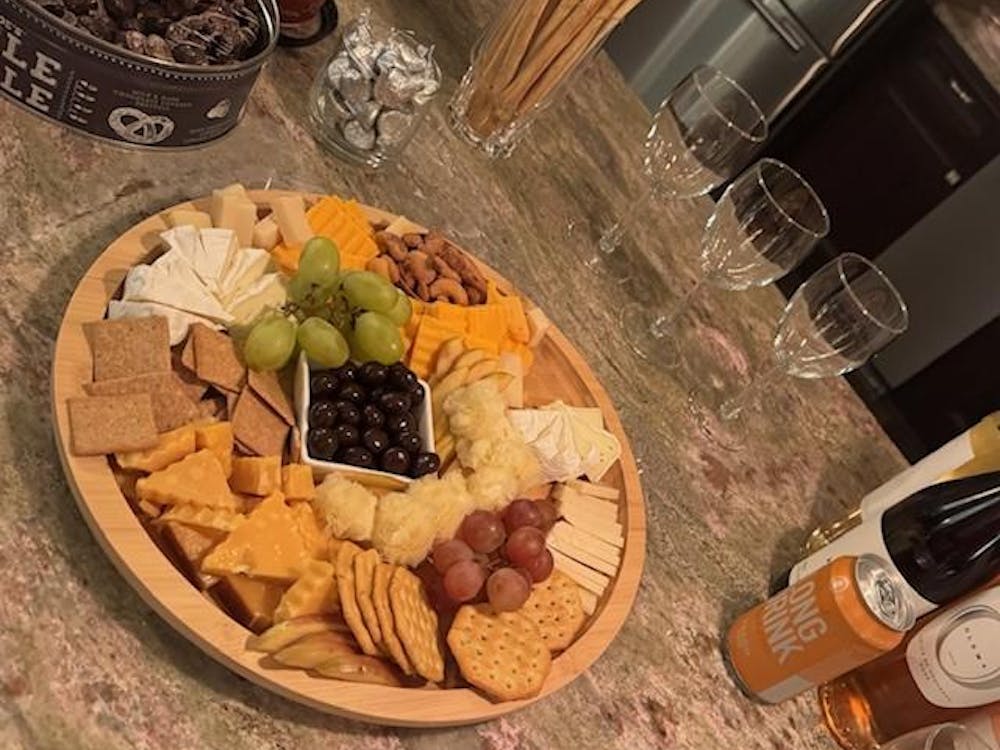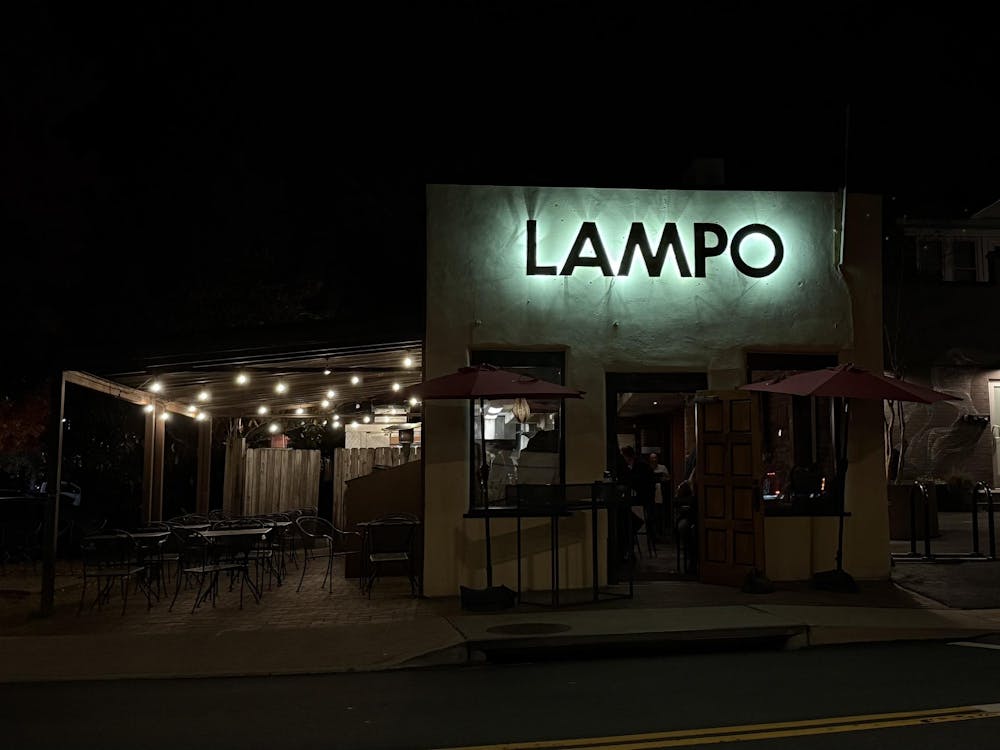He stood on the Lawn early one November morning, surveying the University's architectural jewel, wondering how he could transfigure Jefferson's legacy.
"This can't look like a carnival or a barber shop," Ralph Himelrick said to fourth-year trustee Michael Huneke. "I don't think wrapping lights around the fronts of the pavilions, around the columns and things are going to get it."
"What would you do?" Huneke asked.
And so the Facilities Management electrical supervisor thought about it for a minute. Himelrick, six weeks shy of retiring from a 50-year electrician career, tried to envision how one would go about lighting up the Lawn for the first time in its revered history - with only three weeks'notice. On Dec. 5, the Class of 2002 Trustees wanted to host the first "Lighting of the Lawn."
"Well, I think a one-line outline of the Pavilions, the balconies and the residences - just a one-line - would be tasteful, it would be elegant and," he replied, "it would really, really be beautiful."
Himelrick's mental snapshot of the historic buildings paired with white, outdoor holiday lights - the kind that infuse American suburbia with an annual dose of decorating spirit - proved prophetic. An estimated 5,000 people flocked to the Lawn for the inaugural lighting that was a far cry from any typical neighborhood display.
"Everyone in the audience seemed to marvel at what they were seeing, almost as if they were going to a wonderful fireworks show," said James Murray Howard, curator and architect for the Academical Village.
Getting Howard's approval before the lighting, though, was paramount in Himelrick's mind. Having worked with Howard on Pavilion and Lawn room renovation projects for most of his 13-year tenure at the University, Himelrick knew he would have to meet Howard's exacting structural and aesthetic standards to carry out the project.
They were standards he got a taste of on his first renovation assignment, rewiring Pavilion VI. Unlike a traditional house-wiring job, Himelrick was not allowed to drill holes or pull wire through the walls, and instead had to use alternate methods.
"It was really a chore, but it was so great of an experience for me to get to do it and get to appreciate a historical building, what it really meant," Himelrick said.
His care for the buildings and his knack for rewiring them, which Howard likened to performing "the most delicate surgery," meant that Howard had few concerns about Himelrick tackling the "Lighting of the Lawn." His only stipulations were that it not look like a "honky-tonk" and that "we not do anything to the buildings that we needed to repair."
Translation: no nails.
Instead, Himelrick's two-man crew of Wayne Russell and Shawn Wills eventually had to attach the 26,600 lights and four miles of wire using nothing but plastic ties and pieces of white wire to secure them to the structures.
"You couldn't see it, you'd get right up to it and you couldn't hardly make it out," Himelrick said. "No one, I don't think, ever even realized how they were up there."
At the beginning, no one really knew the lighting plan was in the works, either. A week after their first meeting and after Himelrick had given Huneke a $3,500 to $4,000 cost estimate for the lights and labor, Huneke gave Himelrick the go-ahead to get started.
Because he did not have to seek approval to accept a job, Himelrick set off to buy the lights without a word to his supervisor.
He was returning from Wal-Mart, driving down Route 29, the back of his pick-up truck loaded down with boxes of outdoor lights, when he got a call on his cell phone from his boss, Trades Manager Lee Holsapple. Chris Willis, director of facility operations, wanted to talk to Himelrick. Word had spread.
"Ralph, Chris wants to see you in his office, Holsapple said, "about something that's going on on the Lawn. "Do you know what's going on on the Lawn?" he asked.
"Yeah," Himelrick, with a laugh, recalled saying. "I think I do."
The question of who was going to pay for the project still remained up in the air. Himelrick, excited from the beginning, was willing to donate part of the cost from his work center budget to make it happen. But Chief Facilities Officer Robert Dillman assured him that would not be necessary. In the end a long list of donors made the $8,000 event - including the lights, labor and food - possible. The Class of 2002 Trustees, Third and Second-Year Councils, the Alumni Association, the Office of the Vice President of Student Affairs, the Office of the President and Facilities Management all contributed.
As Russell and Wills started to string the lights the last week in November, Himelrick would check on the work during the day, but never at night. He wanted to wait until the official date to see what would be the capstone to his career.
Fourth-Year Class President Portman Wills and five of the trustees could not hold out that long. Plagued by the thought that it might turn out to be "kind of lame," Portman said the group of six turned on the lights late Sunday, Dec. 1.
Awed by the illuminated scene before them, they sat speechless on the steps of the Rotunda.
"A couple walked up, they were chattering about something mundane, and they just let out the biggest 'Holy [expletive]!' ever, gasped, and said, 'that is one of the most beautiful things I have ever seen'," Portman recounted. "That's when the six of us looked at each other, hugged, high-fived and knew that it was good."
Although the Trustees originally were motivated to come up with a fourth-year activity, the "Lighting of the Lawn," quickly mushroomed into a community-wide event, which its planners thought was especially important after theemotionally draining months that followed Sept. 11.
"It was the first communally joyful thing that occurred," Portman said. "For a lot of people, that was the first time that everyone they saw was happy, and everyone they saw was excited and energized. The timing was just perfect."
Well, almost perfect. Crew members were scheduled to turn the lights on at six different locations at 8:45 p.m. But when Coach Pete Gillen's animated recitation of "T'was the Night Before Finals," started too early, workers had to scramble through the crowds and up to the top of the Pavilion balconies to flip the switches.
"I thought Ralph was going to have a heart attack right there," said Huneke, who was standing with Himelrick.
Once the lights came on, though, there was no stopping the cheering crowd, especially when Portman delivered a speech honoring both Himelrick's role in the lighting and his retirement.
"My favorite moment was when Ralph emerged victoriously from underneath the Rotunda steps," Portman said. "The crowd loved it. The students were chanting 'one more year!'"
For Himelrick, whose co-workers had thrown him a surprise party in Pavilion VII and whose family had joined him for the event, it was the crowning moment of a lifetime of hard work.
"I felt like I was going to retire on a top note," he said. "It was the best feeling I've had at the University."
And though he may not be in charge of it again, Himelrick joins the strong contingent already planning to transform this event into another hallowed University tradition.
"The lights are down and stored, waiting for next year - hoping for next year," he said.






